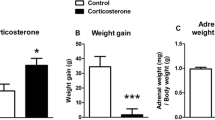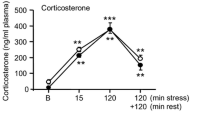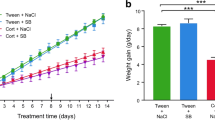Abstract
8-OH-DPAT, a selective 5-HT1A agonist, produced a hypothermic response in mice at a dosage of 0.5 mg/kg. Administration of corticosterone-21-acetate (0.5, 5 and 50 mg/kg, daily for 3 and 10 days) produced a dose-dependent attenuation of this hypothermic response in mice. When all controls and corticosterone treated mice were retested, 14 days after initial testing, they did not differ in the hypothermic responses induced by 8-OH-DPAT. Mice treated with aldosterone (50 mg/kg), dexamethasone (50 mg/kg) and the specific type 2 corticosteroid receptor agonist, 11b,17b-dihydroxy-21-methyl-17a-pregna-1,4,6-trien-20-yn-3-one (RU26988, 30 mg/kg) for 10 days, did not differ from vehicle treated controls in the hypothermic response to 8-OH-DPAT. Mice administered corticosterone-21-acetate (30 mg/kg, daily) for 10 days displayed a motor behavioural syndrome, which was not seen in controls, when injected with 5-hydroxytryptophan (5-HTP, 100 mg/kg) 15 min after the injection of carbidopa (25 mg/kg). This was significantly decreased by pretreatment with the 5-HT1A receptor antagonist 1-(2-methoxyphenyl)-4-(4-phthalimidobutyl)-piperazine (NAN-190 5 mg/kg, 30 min prior to administration of carbidopa). Taken together, this evidence is compatible with a specific corticosterone induced facilitation of 5-HT release due to attenuation of inhibitory 5-HT1A autoreceptor function.
Similar content being viewed by others
References
Biegon A, Rainbow TC, McEwen BS (1985). Corticosterone modulation of neurotransmitter receptors in rat hippocampus: a quantitative autoradiographic study. Brain Res 332:309–314
Bill DJ, Knight M, Forster EA, Fletcher A (1991) Direct evidence for an important species difference in the mechanism of 8-OH-DPAT induced hypothermia. Br J Pharmacol 103:1857–1864
Blackburn IM, Whalley LJ, Christie JE, Shering A, Foggo M, Bennie J, Farrer D, Watts G, Wilson H, Fink G (1987) Mood, cognition and cortisol: their temporal relationships during recovery from depressive illness. J Affective Disord 13:31–43
Boston Collaborative Drug Surveillance Program (1972). Adverse reactions to prednisone in relation to dosage. Clin Pharmacol Ther 13:694–698
Christie JE, Whalley LJ, Dick H, Blackwood DHR, Blackburn IM, Fink G (1986) Raised plasma cortisol concentrations a feature of drug free psychotics and not specific for depression. Br J Psychiatry 148:58–65
Deakin JFW, Green AR (1978) The effects of the putative 5-hydroxytryptamine antagonists on the behaviour produced by administration of tranylcypromine andl-tryptophan orl-dopa to rats. Br J Pharmacol 64:201–209
De Kloet ER, Reul JMHM (1987). Feedback action and tonic influence of corticosteroids on brain function: a concept arising from the heterogeneity of brain receptor systems. Psychoneuroendocrinology, 12:83–105
De Kloet ER, Versteeg DHG, Kovacs GL (1983). Aldosterone blocks the response to corticosterone in the raphe-hippocampal serotonin system. Brain Res 264:323–327
Fink G, Robinson IACF, Tannahill LA (1988) Effects of adrenalectomy and glucocorticoids on the peptides CRF-41, AVP and oxytocin in rat hypophysial portal blood. J Physiol 401:329–345
Glennon RA, Naiman NA, Pierson ME, Titeler M, Lyon RA, Weisberg M (1988) NAN-190: an arylpiperazine analog that antagonizes the stimulus effects of the 5-HT1A agonist 8-hydroxy-2-(di-n-propylamino)tetralin (8-OH-DPAT). Eur J Pharmacol 154:339–341
Goodwin GM (1989) The effects of antidepressant treatments and lithium upon 5-HT1A function. Prog Neuropsychopharmacol Biol Psychiatry 13:445–451
Goodwin GM, De Souza, RJ, Green AR (1985) The pharmacology of the hypothermic response in mice to 8-hydroxy-2-(di-n-propylamino)tetralin (8-OH-DPAT). Neuropharmacology 24:1187–1194
Goodwin GM, De Souza RJ, Green AR, Heal DJ (1987) The pharmacology of the hypothermic and behavioural responses of rats to 8-hydroxy-2-(di-n-propylamino)tetralin (8-OH-DPAT). Psychopharmacology 91:506–511
Goodwin GM, Muir WJ, Seckl JR, Bennie J, Carrol S, Dick H, Fink G (1992). The effects of cortisol infusion upon hormone secretion from the anterior pituitary and subjective mood in depressive illness and controls. J Affective Disord 26:73–84
Grahame-Smith DG (1989) Serotonin function in affective disorders. Acta Psychiatr Scand 89:7–12
Hartig P (1989) Molecular biology of 5-HT receptors. TIPS 10:64–66
Harrington MA, Zhong P, Garlow SJ, Ciaranello RD (1992) Molecular biology of serotonin receptors. J Clin Psychiatry 53 [10 (suppl)]:8–27
Hillegaart V (1990). Effects of local application of 5-HT and 8-OH-DPAT into the dorsal and median raphe nuclei on core temperature in the rat. Physiol Behav 48[1]:143–148
Holsboer F (1989) Psychiatric implications of altered limbic-hypothalamic-pituitary-adrenocortical activity. Eur Arch Psychiatr Neurol Sci 238:302–322
Hunter R, Dick H, Christie JE, Goodwin GM, Fink G (1988) Lymphocyte glucocorticoid receptor binding in depression: normal values following recovery. J Affective Disord 14:155–159
Lesch KP, Mayer S, Disselkamp-Tietze J, Hoh A, Schoellnhammer G, Schulte HM (1990b) Sub-sensitivity of the 5-hydroxytryptamine1A (5-HT1A) receptor-mediated hypothermic response to isapirone in unipolar depression. Life Sci 46:1271–1277
Mendelson SD, McEwen BS (1990) Adrenalectomy increases the density of 5-HT1A receptors in rat hippocampus. Neuroendocrinol Lett 12:353–365
Mosian MP, Seckl JR, Edwards CRW (1990) 11b-Hydroxysteroid dehydrogenase bioactivity and messenger RNA expression in rat forebrain: localization in hypothalamus, hippocampus and cortex. Endocrinology 127, [3]:1450–1455
Sharp T, Hjorth S (1990) Application of brain microdialysis to study the pharmacology of the 5-HT1A autoreceptor. J Neurosci Methods 34:83–90
Van der Kar SD (1989) Neuroendocrine aspects of the serotonergic hypothesis of depression. Neurosci Biobehav Rev 13:237–246
Wodarz N, Rupprecht R, Kornbuher J, Schmitz B, Wild K, Riederer P (1992) Cell-mediated immunity and its glucocorticoid-sensitivity after clinical recovery from severe major depressive disorder. J Affective Disord 25:31–38
Young AH, MacDonald LM, St John H, Dick H, Goodwin GM (1992) The effects of corticosterone on 5-HT receptor function in rodents. Neuropharmacology 31[5]:433–438
Young AH, Dow RC, Goodwin GM, Fink G (1993) Effects of adrenalectomy and ovariectomy on the behavioural and hypothermic responses of rats to 8-hydroxy-2-(di-n-propylamino)tetralin (8-OH-DPAT). Neuropharmacology 32[7]653–657
Author information
Authors and Affiliations
Rights and permissions
About this article
Cite this article
Young, A.H., Goodwin, G.M., Dick, H. et al. Effects of glucocorticoids on 5-HT1A presynaptic function in the mouse. Psychopharmacology 114, 360–364 (1994). https://doi.org/10.1007/BF02244859
Received:
Accepted:
Issue Date:
DOI: https://doi.org/10.1007/BF02244859




